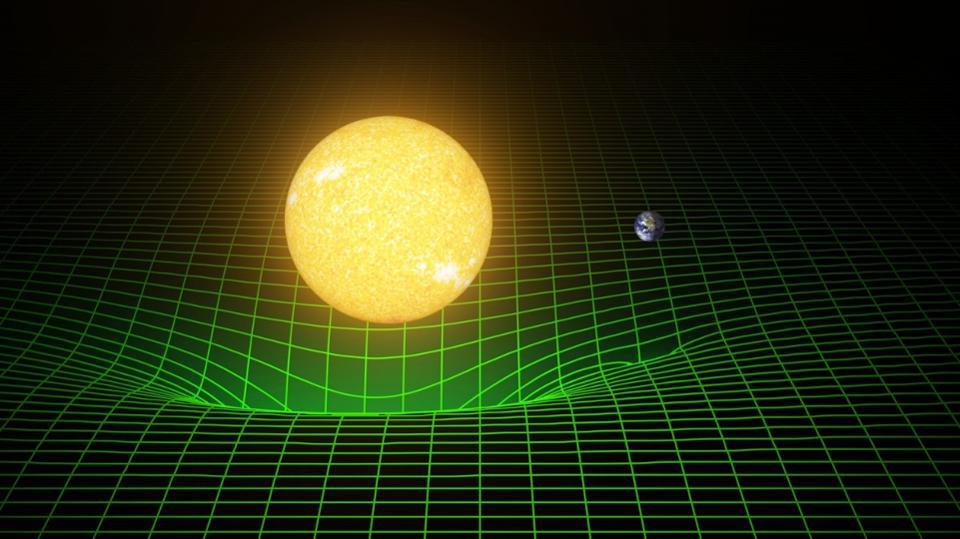MICHELLE THALLER: Eugene, you've asked one of my favorite questions and a surprisingly deep one. The essence of it is: How fast are we really moving? We are a solar system; we are planets going around the Sun. But the Sun has its own motion around the galaxy, the Milky Way. And there are larger motions still because the Milky Way galaxy is also moving through space. So I'm going to try to break this down because there are a number of different ways to think about motion because when you get to these scales, one of the most important questions you have to ask is: Motion compared to what? And I'll explain that as I go along.
So one of the most easy to understand motions, but a kind of mind-blowing one is that the Sun is orbiting around the center of the Milky Way galaxy. Now, the Milky Way galaxy is a huge collection of about half a trillion stars, and it's about 100,000 light years across end-to-end. Now, we actually orbit around the center of the galaxy -- the center of the galaxy is about 30,000 light years away from us -- and we orbit around about once every 230 million years. OK, that sounds like a long time. So 230 million years to make one orbit around the galaxy. So how fast are we going? It turns out that the Sun, and us with it, it's going at about 560,000 miles an hour. That's over half a million miles an hour just around the center of our galaxy. So right now, you are moving at over half a million miles an hour around the center of the galaxy. And if you want to think about it in kind of a dramatic way, the center of the galaxy has a massive black hole at the middle, and it's about 4 million times the mass of the Sun. So right now, you are orbiting a massive black hole at half a million miles an hour. That's kind of fun.
But there are larger velocities as well. And here's where things start to get a little bit complicated because the universe is expanding. And what that really means is that space itself is expanding. It's not really correct to say the galaxies are flying through the universe with the expansion of the universe. That's actually not how it works at all. The galaxies in that sense are standing still, but the space in between them is getting bigger. It's a very strange thing to think about, but the expansion of the universe is not galaxies moving through empty space. And one of the reasons that this is important is because the farther away you look into space, the more expanding space you look through. And it's not that galaxies very far away are actually moving through space very, very fast, but they appear that way to us. There's something called the Hubble Constant, and what that means is how fast the universe is expanding for every amount of space that you look through. The Hubble constant right now is about 75 kilometers per second per megaparsec, and a megaparsec is about 3 million light years. So that means that every 3 million light years you go out, things are receding from you at an additional 75 kilometers per second. So when you're 3 million light years away, a galaxy would naturally recede away from you at 75 kilometers per second. Now double that. Say that you're now 6 million light years away, double 75: 150 kilometers per second. So for every 3 million light years you go out, you put an additional 75 kilometers per second onto the speed.
Now, that means the galaxies nearer to us are not moving very quickly at all in the natural expansion of the universe. But if you look at something billions of light years away, you're looking through that much expanding space, and it can be receding away from us, appearing to recede away from us, at a very fast velocity indeed. In fact, when you actually look at the very, very edges of the universe, things are receding away from us close to the speed of light. So that's not anything moving at the speed of light. That's just the fact that you're looking through that much expanding space that it appears to be going that fast away from you, and this is called the Hubble Law.
It took a long time for people to realize that there might be other motions besides just this expansion of the universe. And we have to tease them out because galaxies, as big as they are and as fast as they're moving, the distances they're moving across are so vast it's very difficult to detect. Over time we realized that yes indeed there were other motions besides this, what we call Hubble flow, this expansion of the universe. So we began to realize that the Milky Way galaxy was part of larger clusters of galaxies. And in some cases, clusters of galaxies were bound together by gravity, sort of orbiting around big groups of galaxies. And in other cases, these concentrations of galaxies are probably going to disperse over time as the universe expands.
So starting from relatively close to us, the closest large galaxy to us is Andromeda. And Andromeda is so big and so close that in fact, we are falling towards each other faster than the universe expanding us away. Right now the Andromeda galaxy is coming at us at a speed of about 300,000 miles an hour. And that means that's going to collide with us in a couple billion years so I wouldn't worry about that, that's not a problem for us at all. And in fact, we think the Milky Way has collided with other galaxies in the past as well. But the reason Andromeda is coming toward us is the force of gravity is accelerating us together faster than the expansion is taking it away. Other galaxies even closer to us are orbiting the Milky Way, like the Magellanic Clouds.
So now, let's go out a little bit further and think about how the Milky Way is moving through space compared to larger things. Well, the largest motion we know of right now is that we are falling in towards something called the Great Attractor. And this is a concentration of mass, a giant cluster of galaxies. And right now, we're moving at a little over one and a half million miles an hour towards that part of the sky. For a long time, we really didn't know what was there. We called it the Great Attractor because it seemed kind of mysterious. But now, we realize that it's actually the center of gravity of a huge cluster of galaxies, something called a super cluster. And this cluster probably contains over 100,000 galaxies, and it's probably on the order of about half a billion light years across. And this has been discovered only in the last few years, and it's been called the Laniakea Supercluster. Laniakea is the Hawaiian language word for the highest heaven. And this is the largest group of galaxies that we think that we are actually gravitationally associated with. We are actually falling in towards the center of this giant collection of galaxies.
So where's the Sun going? How are we moving? It depends on with respect to what. We're moving around the galaxy at half a million miles an hour. We're falling into the center of a supercluster of galaxies at one and a half million miles an hour. And all of that is superimposed on top of the expansion of the universe, which isn't really a speed, it's just that you have to look through a lot of expanding space. So there's no one answer as to how fast you're moving right now. And I think that's one of the most wonderful things is how complex these simple answers can get.






